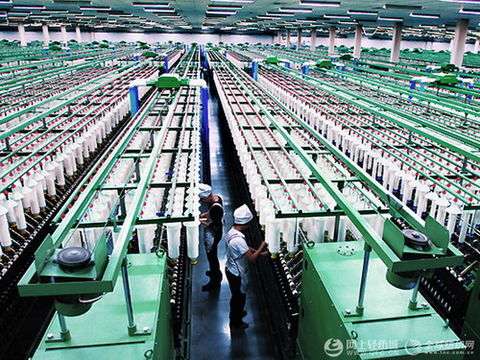Joseph Wozniak, head of the International Trade Center's sustainable development trade project, said on November 28 that since China's accession to the WTO, China has increased its global textile product exports by eight times and has become the world's largest textile exporter.

Jiang Hui, president of the China Chamber of Commerce for Import and Export of Textiles, said that China is difficult to be subverted within ten years of being the world's largest textile exporter.
Joseph Wozniak and Jiang Hui made the above comments at the “China-Europe Sustainable Supply Chain High-Level Forum†held on November 29.
China and the EU are both important textile exporters and consumer markets in the world. Textile trade is an important part of bilateral trade between China and Europe.
China's textile exports are about 270 billion US dollars, the EU ranks second, about 170 billion US dollars, and the third is India and Bangladesh, with an export value of about 340 billion dollars.
Since China’s accession to the World Trade Organization, especially since the global textile trade in ushered in the “zero quota era†in 2005, the scale of China-EU textile trade has expanded rapidly.
According to China Customs statistics, in 2015, China's textile and apparel exports to the EU reached 53.132 billion US dollars, and EU textile and apparel exports to China reached more than 4 billion US dollars, both of which were nearly doubled in 2005. In 2015, the bilateral trade volume between China and the EU was 564.75 billion US dollars. Textile and apparel trade accounts for 1/10 of China-EU bilateral trade.
China is the largest country in the global textile industry, and the country with the most complete industrial chain and the most complete categories. Chinese textiles include yarn fabrics and clothing. In 2015, China's fiber processing volume reached 53 million tons, accounting for more than 50% of the world's total. The EU has comparative advantages in product development, technology, design and branding.
Jiang Hui used a set of data to show that China's textile and apparel exports are currently in a state of increasing price.
In the first 10 months of this year, China’s textile exports totaled US$219.54 billion, down 6.5% year-on-year.
Among them, textile exports amounted to 87.34 billion US dollars, down 4.1%. However, in terms of volume, the export yarn was 3.41 million tons, a year-on-year increase of 14%, of which cotton yarn exports were 270,000 tons, with almost no increase of only 0.1%, and chemical fiber yarn exports of 2.52 million tons, an increase of 20%.
Jiang Hui said that the above data shows that China's textile exports are growing, but the trade market share is declining. “That means that foreign friends bought more things with less money.â€
Jiang Hui said that the current external demand for China's textile and garment industry is still good, but the trade growth is weak. He believes that the trade pressure of Chinese textile has both external and internal factors.
From the external environment, the Chamber of Commerce for Import and Export of Textiles believes that the US economy is not bad. Europe and Japan will not be too good for some time to come. The development of the BRICS countries as emerging economies is uneven, and China’s economic growth rate is mixed. It will slow down before. Jiang Hui said that due to the large consumption base of textiles and clothing in China, it is hard to say whether textile and apparel consumption will continue to show double-digit growth next year.
Domestically, textile production capacity is increasing. Jiang Hui takes Xinjiang as an example. Last year, the textile production capacity was 8 million spindles. It is estimated that it will reach 15 million spindles next year. In addition, it may reach 20 million spindles in the future.
According to Jiang Hui, there are currently more than 12,000 companies in China's textile and apparel industry, and 5,000 are members of the China Chamber of Commerce for Import and Export of Textiles.
Jiang Hui said that from the internal factors of the industry, the domestic production capacity of the textile industry is seriously superimposed. So far, 75% of China's production capacity is concentrated in the five provinces of Guangdong, Fujian, Zhejiang, Jiangsu and Shandong. “The industry shift is slow, the production capacity is superimposed, and the products are mainly concentrated in the low-end.â€
“China has entered the era of consumer economy, and profits are increasingly leaning toward the terminal.†Jiang Hui said that the rise of e-commerce and online shopping has made consumption irregular, and consumption rhythm, consumption patterns and consumer psychological tensions are completely different from the past.
The value chain of the industrial chain of the textile industry is tilted towards the terminal. Jiang Hui believes that the industrial environment is increasingly affected by policies and capital.
He used cotton as an example. The cotton market is not in a bull market, and cotton supply is sufficient, but cotton prices are high. "This is because capital is at work. In addition, it does not operate according to the relationship between supply and demand, and becomes a game of capital." He believes that the deeper reason is that hot money runs from real estate to the stock market and then to the cotton industry.
Jiang Hui believes that the driving force of the textile industry in the future is to improve product quality, strengthen industrial innovation and enhance Internet awareness.
With the two treasures of Luo Jin, you can also be a strong sister (Figure)
Accessories For Home,Flannel Fleece,Velvet Fleece Fabric,Velvet Fleece,Travel Pillows
Yangzhou Youju E-commerce Co.,Ltd , https://www.yzxygarments.com
